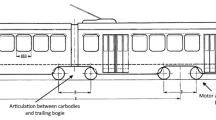Abstract
Drivetrains play an essential role in guaranteeing the reliability of wind turbines. A challenge in their design is the wide range of loading conditions they are exposed to. Several design load cases are required to be simulated in order to ensure that the ultimate loads are not exceeded, and to validate that the fatigue lifetime matches the design requirements. These loading conditions include among other (emergency) stops, start-ups, and normal and parked operation in different ambient conditions (wind speed, wave height, …). The design requirements are validated through a combination of functional, robustness and system tests when the turbine is operated in the design load cases. Within the context of Industry 4.0, turbines are becoming increasingly equipped with sensors. This offers opportunities for the in-depth validation of design hypotheses, as it allows to obtain detailed insights in the occurrence of loading events to which turbines are exposed to throughout their lifetime. This can be incorporated in future design iterations to further optimize the design based on more realistic loading conditions. The goal of this paper is to automatically and continuously classify SCADA data of an offshore farm in the aforementioned design load cases on a farm-wide level. Using this framework, the effects of wake on loading conditions are assessed in a data-driven manner.







Similar content being viewed by others
References
Komusanac I, Daniel F, Guy B (2019) Wind energy in Europe in 2019—trends and statistics. In: Wind Europe, pp 9–10
Helsen J, Vanhollebeke F, Vandepitte D, Desmet W (2012) Some trends and challenges in wind turbine upscaling. In: Proceedings of ISMA International Conference on Noise And Vibration 2012, pp 4345–4359
Tchakoua P, Wamkeue R, Ouhrouche M, Slaoui-Hasnaoui F, Tameghe TA, Ekemb G (2014) Wind turbine condition monitoring: state-of-the-art review, new trends, and future challenges. Energies 7(4):2595–2630
Hameed Z, Hong YS, Cho YM, Ahn SH, Song CK (2009) Condition monitoring and fault detection of wind turbines and related algorithms: a review. Renew Sustain Energy Rev 13(1):1–39
Zwick D, Michael M (2015) The simulation error caused by input loading variability in offshore wind turbine structural analysis. Wind Energy 18(8):1421–1432
Roach S, Park SM, Gaertner E, Manwell J, Lackner M (2020) Application of the new IEC international design standard for offshore wind turbines to a reference site in the massachusetts offshore wind energy area. In: Journal of Physics: Conference Series
Faulstich S, Berthold H (2011) Wind turbine downtime and its importance for offshore deployment. Wind Energy 14(3):327–337
Nejad A, Rasekhi Z, Torgeir M (2014) On long-term fatigue damage and reliability analysis of gears under wind loads in offshore wind turbine drivetrains. Int J Fatigue 61:116–128
Vanhollebeke F (2015) Dynamic analysis of a wind turbine gearbox towards prediction of mechanical tonalities. PhD dissertation, KU Leuven, Belgium
Daems PJ, Guo Y, Sheng S, Peeters C, Guillaume P, Helsen J (2020) Gaining insights in loading events for wind turbine drivetrain prognostics. In: Turbomachinery Technical Conference & Exposition
Guo Y, Sheng S, Phillips C, Keller J, Veers P, Williams L (2020) A methodology for reliability assessment and prognosis of bearing axial cracking in wind turbine gearboxes. Renew Sustain Energy Rev 127:109888
Vaes D, Guo Y (2019) Roller sliding in wind turbine gearbox high-speed shaft bearings. National Renewable Energy Lab (NREL), Golden, USA
Vaes D, Guo Y (2019) Roller sliding in wind turbine gearbox high-speedshaft bearings. In: 4th Conference for Wind Power Drives
Pfaffel S, Faulstich S, Rohrig K (2017) Performance and reliability of wind turbines: a review. Energies 10(11):1904
Acknowledgements
The authors gratefully acknowledge the financial support via the MaDurOS program from VLAIO (Flemish Agency for Innovation and Entrepre-neurship) and SIM (Strategic Initiative Materials) through project SBO MaSiWEC (HBC.2017.0606). The authors would also like to acknowledge the support of De Blauwe Cluster through the project Supersized 4.0. The authors would also like to acknowledge FWO (Fonds Wetenschappelijk Onderzoek) for their support through the SB grant of Timothy Verstraeten (#1S47617N).
Author information
Authors and Affiliations
Corresponding author
Rights and permissions
About this article
Cite this article
Daems, PJ., Verstraeten, T., Peeters, C. et al. Effects of wake on gearbox design load cases identified from fleet-wide operational data. Forsch Ingenieurwes 85, 553–558 (2021). https://doi.org/10.1007/s10010-021-00444-3
Received:
Revised:
Accepted:
Published:
Issue Date:
DOI: https://doi.org/10.1007/s10010-021-00444-3




